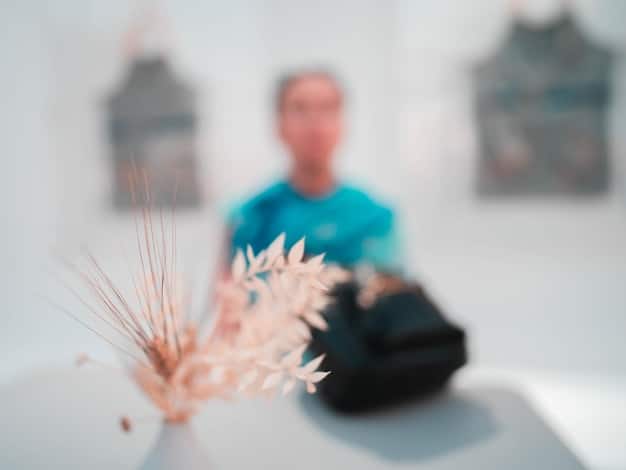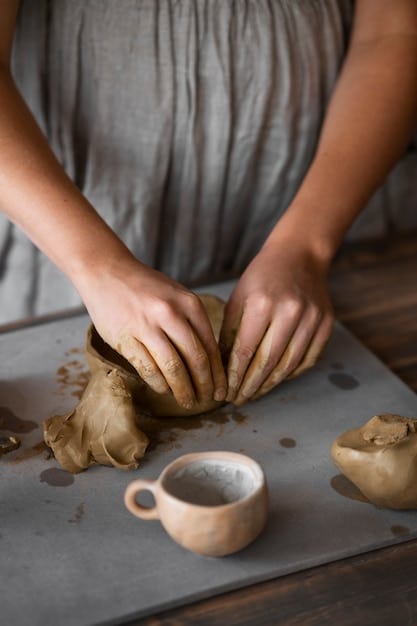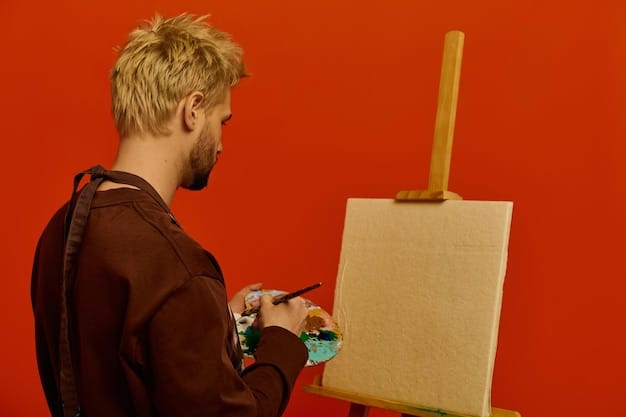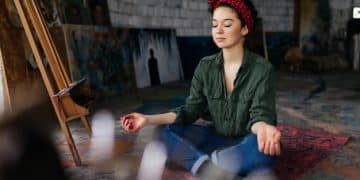Zen and Creativity: Unleash Your Inner Artist

Zen and Creativity explores how mindfulness and intuition, core tenets of Zen philosophy, can unlock artistic potential by fostering presence, reducing self-criticism, and enhancing imaginative flow.
Have you ever felt blocked, creatively stifled, or disconnected from your inner artist? Exploring **Zen and Creativity: Unleashing Your Inner Artist Through Mindfulness and Intuition** could be the key to unlocking your artistic potential and rediscovering the joy of creation.
The Essence of Zen and its Connection to Creativity
Zen Buddhism, with its roots in ancient wisdom, offers a path to inner peace and clarity. But its principles extend far beyond meditation cushions, deeply impacting our creative processes. Understanding this connection can transform how we approach art and life.
Zen’s emphasis on mindfulness and being present in the moment directly counters the anxieties and self-doubt that often plague artists. By fostering a state of calm awareness, Zen practices allow creativity to flow more freely, unburdened by the ego’s incessant chatter.
Mindfulness and the Creative Flow
Mindfulness encourages us to fully engage with the present moment, observing our thoughts and feelings without judgment. This practice is incredibly beneficial for creative work.
Intuition as a Creative Compass
Zen also values intuition, the ability to understand something instinctively, without conscious reasoning. Honing our intuitive sense can lead to unexpected and innovative artistic breakthroughs.
- Mindfulness Meditation: Regular practice cultivates focus and reduces mental clutter.
- Sensory Awareness Exercises: Engaging fully with sights, sounds, and textures enhances present moment awareness.
- Non-Judgmental Observation: Observe your thoughts and emotions without criticism, fostering self-acceptance.
By incorporating these principles, one can tap into a deeper wellspring of inspiration and artistic expression. Cultivating a Zen mindset allows artists to approach their work with greater openness, curiosity, and acceptance.

In conclusion, the essence of Zen is deeply intertwined with enhancing creativity. By embracing mindfulness and trusting intuition, artists can break through creative barriers and discover new perspectives.
Meditation Techniques to Ignite Your Artistic Spark
Meditation is frequently used for stress relief and inner peace. It is one of the most powerful tools within the Zen tradition that can be skillfully applied to fuel creativity. These techniques facilitate access to new creative depths.
Specific meditation practices can train our minds to be more receptive to creative insights. These methods not only calm the mind but also stimulate imaginative thought and promote an environment where inspiration can flourish.
Zazen: Foundation of Zen Meditation
Zazen, or seated meditation, forms the cornerstone of Zen practice. By learning to quiet the mind in stillness, we can create space for creative ideas to emerge.
Walking Meditation: Finding Creativity in Motion
Walking meditation offers a dynamic alternative to seated practice. The rhythmic movement can help to soothe restless minds and encourage new perspectives.
- Guided Imagery Meditation: Visualizing creative scenes can spark new ideas.
- Mindful Breathing Exercises: Focus on the breath to center yourself and reduce anxiety.
- Body Scan Meditations: Increasing body awareness promotes overall mindfulness and emotional balance.
These techniques don’t require years of practice to yield benefits. Regular application, even for short periods, can significantly impact your creative output.
In summary, incorporating meditation techniques into your daily routine can act as a catalyst for creative insight. Through Zazen, walking meditation, and other focused practices, artists can create space for fresh ideas to emerge and flourish.
Cultivating Mindfulness in Daily Artistic Practice
Beyond formal meditation, mindfulness can be woven into the fabric of everyday artistic activities, enhancing every brushstroke, note, or word. When fully present, the act of creation itself becomes a form of meditation.
Integrating mindfulness into your daily routines transforms ordinary moments into opportunities for artistic discovery. By paying attention to sensory details and engaging fully with your materials, you can unlock new avenues for creative expression.
Mindful Observation: Seeing with New Eyes
Taking time to observe the world around you with heightened awareness can reveal beauty in unexpected places. This practice expands your creative palette and refines your artistic sensibilities.
Engaging the Senses: Immersing Yourself in Experience
Actively engaging your senses – sight, sound, touch, taste, and smell – deepens your connection to the present moment and enriches your creative inspiration.
- Mindful Sketching: Focusing on each line and shadow with complete awareness.
- Intuitive Painting: Allowing your emotions to guide your brushstrokes without conscious planning.
- Present Moment Writing: Capturing thoughts and sensations as they arise, without editing.
By intentionally incorporating these practices, you can transform your artistic process into a mindful journey of self-discovery. The process is what becomes important.
In conclusion, mindfulness is a powerful tool when integrated into daily artistic routines. Attention to detail and full engagement with the senses results in enhanced inspiration from unlikely places.

Overcoming Creative Blocks with Zen Principles
Creative blocks can feel like insurmountable barriers, shutting down the flow of inspiration. However, Zen principles offer a pathway to navigate these obstacles with grace and resilience. By learning to accept and release resistance, artists can rediscover their creative momentum.
Creative blocks are often rooted in fear of failure, perfectionism, and self-criticism. Zen’s emphasis on non-judgmental awareness can help artists detach from these limiting beliefs and approach their work with renewed freedom.
Acceptance and Letting Go
Recognizing and accepting the presence of a creative block is the first step toward overcoming it. Resisting or fighting the block only amplifies its power.
Finding Freedom in Imperfection
Zen teaches us to embrace the beauty of imperfection, known as “wabi-sabi.” Letting go of the need for perfection allows for experimentation and unexpected discoveries.
- Shifting Focus: Instead of forcing a solution, try working on a different aspect of the project.
- Embracing Beginner’s Mind: Approaching your art with the curiosity and openness of a beginner.
- Mindful Breaks: Stepping away from the work to clear your head and refresh your perspective.
These practices encourage a more flexible and accepting approach to the creative process. When we embrace challenges as opportunities for growth, we can transform creative blocks into stepping stones.
In conclusion, Zen principles can be exceptionally helpful in surmounting creative roadblocks. An attitude of acceptance and freedom from perfection, allows for growth during difficult times.
The Role of Intuition in Zen-Inspired Art
Intuition, often described as a “gut feeling” or inner knowing, plays a central role in Zen-inspired art. By quieting the rational mind and listening to our intuitive voice, we can tap into a deeper source of creative wisdom. This path opens the door to unexpected and authentic artistic expression.
Intuition arises from a synthesis of past experiences, subconscious awareness, and innate understanding. By cultivating a receptive state of mind, artists can access this powerful resource and allow it to guide their creative choices.
Trusting Your Inner Guidance
Learning to trust your intuition requires practice and self-awareness. Pay attention to subtle cues – bodily sensations, emotional responses, and spontaneous thoughts – that signal your intuitive insights.
Cultivating a Receptive Mindset
Zen practices such as meditation and mindfulness help to quiet the mental chatter and create space for intuitive insights to emerge. A calm and focused mind is more receptive to subtle signals.
- Automatic Drawing: Letting your hand move freely across the page without conscious control.
- Dream Journaling: Recording and exploring your dreams for symbolic meaning and creative inspiration.
- Creative Visualization: Imagining the finished artwork in detail to stimulate intuitive direction.
By consciously cultivating these practices, you can strengthen your connection to your intuitive self and unlock new dimensions of artistic expression. Learning to trust your inner voice can open up new horizons for your art.
In conclusion, intuition plays a critical role in making Zen-inspired art. Learning to trust your inner voice contributes to a more authentic and personal artistic style.
Integrating Zen into Your Creative Environment
The spaces where we create profoundly influence our artistic practice. By designing a Zen-inspired environment, we can foster a sense of calm, focus, and creative inspiration. Minimalism, natural light, and mindful arrangement all contribute to a space that nurtures artistic flow.
A Zen-inspired environment transcends mere aesthetics; it is a sanctuary that supports mental clarity and emotional well-being. By incorporating elements of simplicity, nature, and intention, you can transform your creative space into a haven for inspiration.
Creating a Minimalist Space
Decluttering your physical environment reduces distractions and creates space for mental clarity. A minimalist space allows your attention to focus on the essentials.
Bringing Nature Indoors
Incorporating natural elements such as plants, stones, and natural light connects you to the earth and promotes a sense of tranquility. Nature can be a powerful source of inspiration.
- Mindful Organization: Arranging your art supplies in a way that is both functional and aesthetically pleasing.
- Color Palette: Choosing calming and harmonious colors for your walls and furnishings.
- Personal Touches: Adding meaningful objects that inspire and uplift your spirit.
By mindfully curating your creative environment, you can cultivate a space that supports your artistic practice and enhances your overall well-being. When you are surrounded by beauty and tranquility, creativity naturally flourishes.
In conclusion, imbuing the creative environment with Zen principles, promotes inspiration and tranquility. By decluttering and bringing nature indoors, the artist nurtures their emotional wellbeing.
| Key Point | Brief Description |
|---|---|
| 🧘 Mindfulness | Enhances present moment awareness and reduces distractions. |
| 🎨 Intuition | Taps into subconscious wisdom for unique creative insights. |
| 🚫 Overcoming Blocks | Acceptance and non-judgmental mindset foster resilience. |
| 🌿 Zen Environment | Minimalism and nature inspire calm and focused creativity. |
[Frequently Asked Questions]
▼
Zen principles calm the mind, promoting focus and present moment awareness, which reduces self-criticism and allows creative ideas to flow more freely, leading to innovative artistic expression.
▼
Zazen(seated meditation) and walking meditation are effective for calming the mind. Guided imagery and mindful breathing can help stimulate imagination and reduce anxiety, enhancing creative potential.
▼
Engage fully with your senses during the creative process. Practice mindful sketching, intuitive painting, or present moment writing to cultivate greater awareness and deepen the connection to your art.
▼
Accept the block without judgment and shift your focus. Embrace imperfections, try a different aspect of the project, or take mindful breaks. Approaching it with curiosity turns challenges into opportunities.
▼
Zen inspired spaces foster a sense of calm, focus, and creative inspiration through minimalism, natural light, and mindful arrangement, which nurtures artistic flow and supports mental clarity and wellbeing.
Conclusion
By embracing the principles of Zen, artists can unlock their creative potential and cultivate a deeper connection to their work. Integrating mindfulness, intuition, and mindful practices transforms creativity into a journey of self-discovery, leading to art that is not only beautiful but also deeply meaningful.





